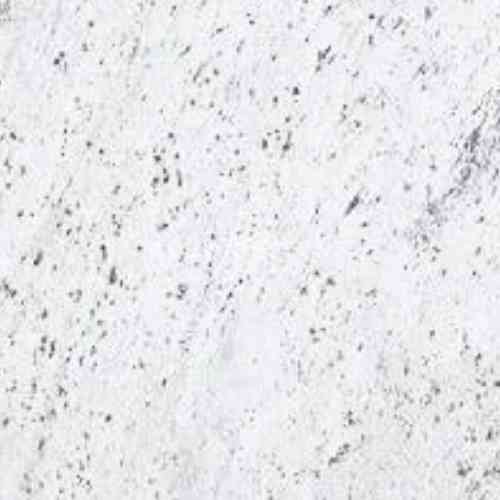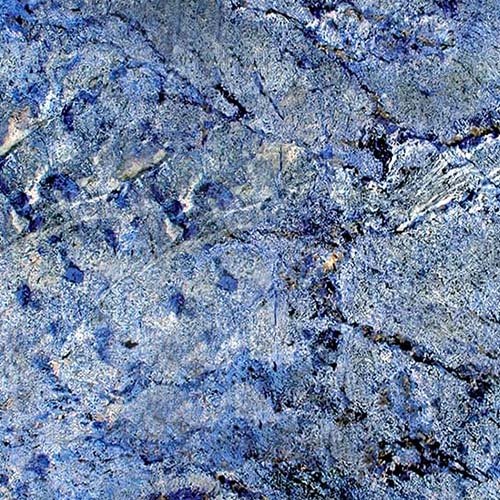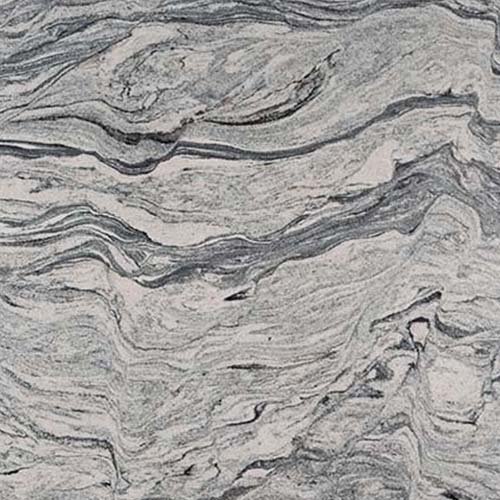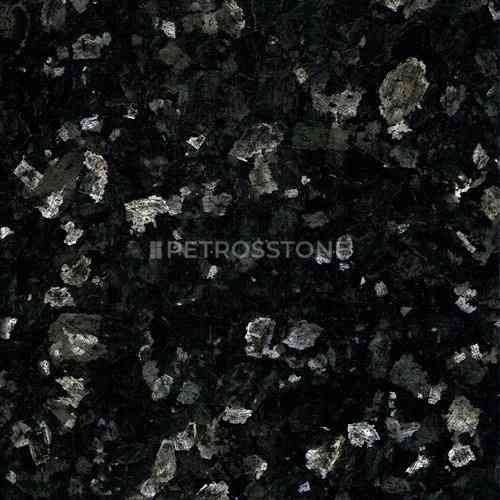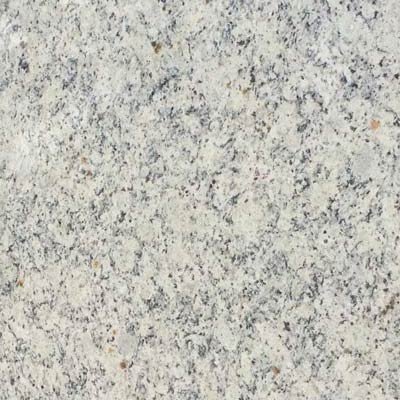
In this article we will look at the best pool coping stones, pool coping materials you should use and we will help you find the right pool coping and its cost for your pool.
Pool coping is the capping or edging which rests against the upper part of a swimming pool wall shell and becomes the finishing touch between the pool basin and deck. There is more to this visible border than the ornamental part; this border seals the crack, covers the sharp edges and structural detailing, and supplies a sitting space, grasping point, or walking surface. Briefly, coping is a minor but essential part of a pool design.
Importance of Choosing the Right Coping Stones
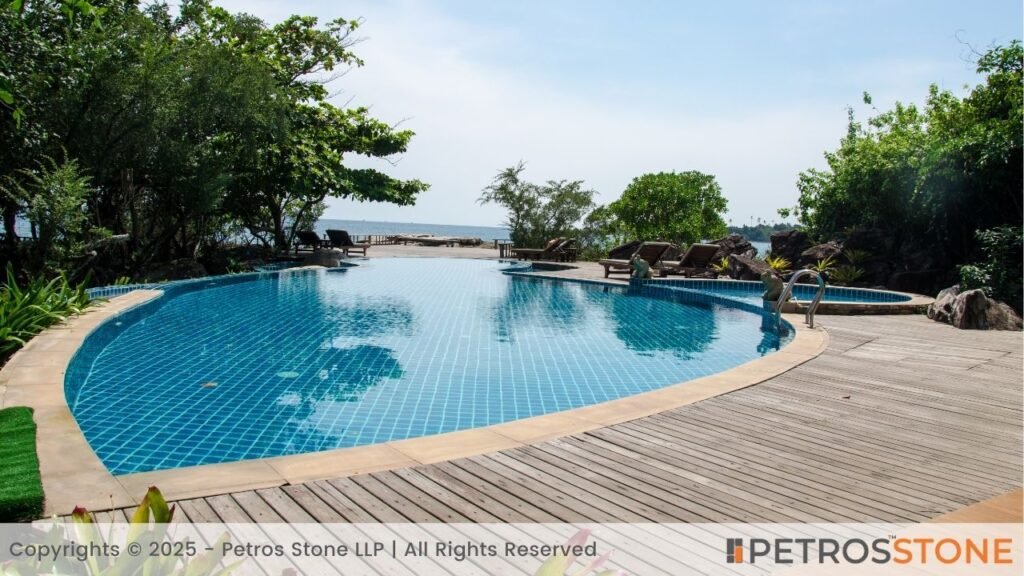
The material that is used to design the coping has an impact on many aspects of the pool experience:
- Safe: The curved edge and a slip-resistant floor exclude accidents and falls.
- Durability: The material should be resistant to water, chemicals, freeze/thaw or foot traffic.
- Maintenance: Properly done maintenance avoids debris, algal growth, and erosion of grout.
- Comfort: Some materials, such as stone, are cool when traversed on bare feet in hot weather, and can thus be used more comfortably barefoot.
- Aesthetic coherence: Coping visually connects the pool to the deck, waterline tile, landscaping or the side of the house.
Aesthetic and Safety Considerations
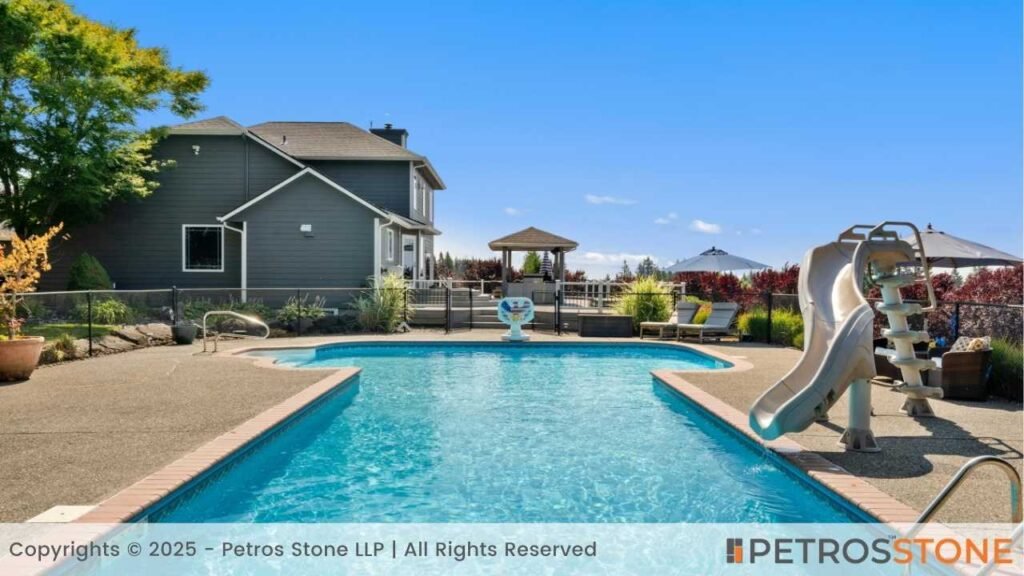
When selecting coping, important considerations include:
- Colour and texture: These must relate to your design, e.g. clean and modern, rugged and Mediterranean, rustic and natural.
- Edge profile: The profile of the design in the edges can be bullnose, bevel or square, and influences the aesthetic and ease of usage.
- Slip resistance: The smooth finishes become slippery in wet conditions; the rougher ones are safer.
- Seaming and junctions: These are placed in the right position to facilitate easier repairs and integrations.
How Coping Impacts Pool Maintenance and Longevity
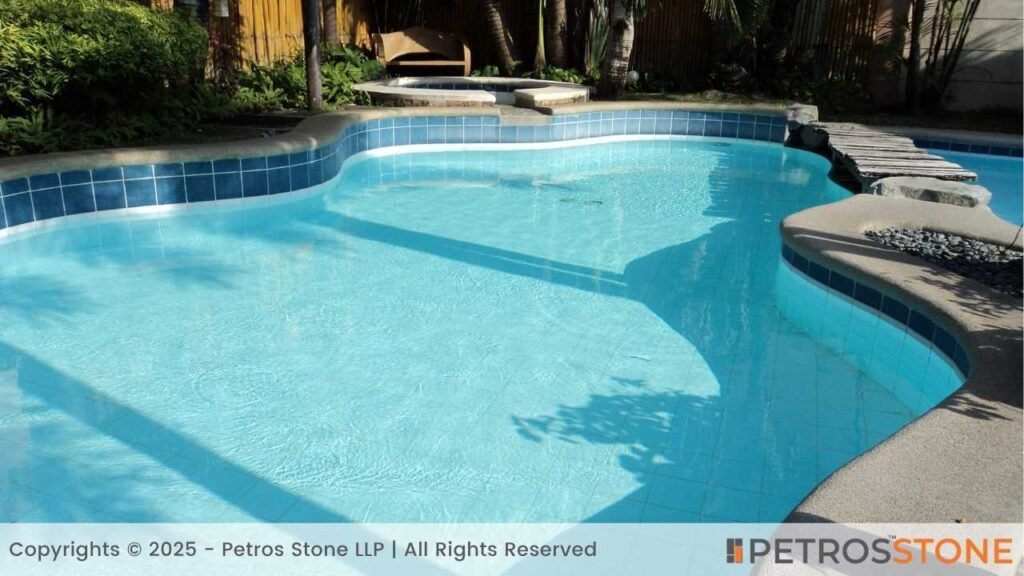
Properly chosen coping will prolong the life of your pool by:
- Shielding the shell: It guards the edge of the pool against damage by splashes and weather.
- Managing water supply: Proper slope and drainage for splash-out will prevent water from cycling towards the decking and foundations.
- Maintenance reduction: Low-porosity, durable coping minimises sealing, discolouration, mildew, or algae.
- Supporting future repairs: Reaccommodation of stones is possible in the event of cracking or breakage with the use of modular coping.
Types of Pool Coping Stones
1. Travertine Pool Coping
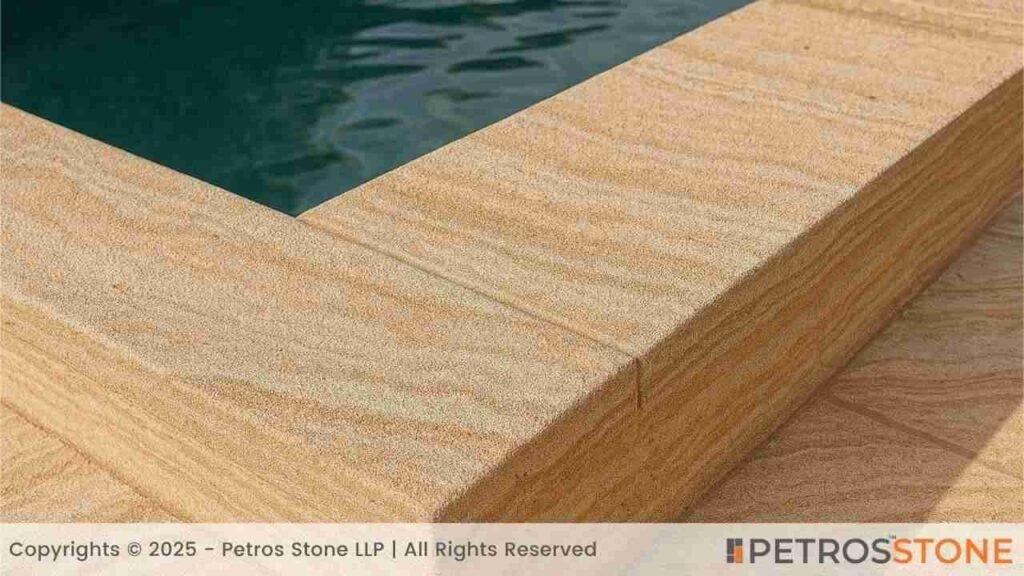
Features and Look
- Tan, honey, buff, warm tones.
- Typical pitting, veining and geographic patterns.
- Tumbled finish aids in smoothing edges and providing slip resistance.
Benefits in Hot Climates
- The porous material is cool to the touch.
- Does not hold on to heat as darker materials do.
- Suited well to warm weather, where people go barefoot.
Travertine Coping Maintenance
- Staining and water absorption are avoided by annual sealing.
- Mild soap and pressure washing.
- Fixation of chips or cracks is easy.
2. Limestone Pool Coping
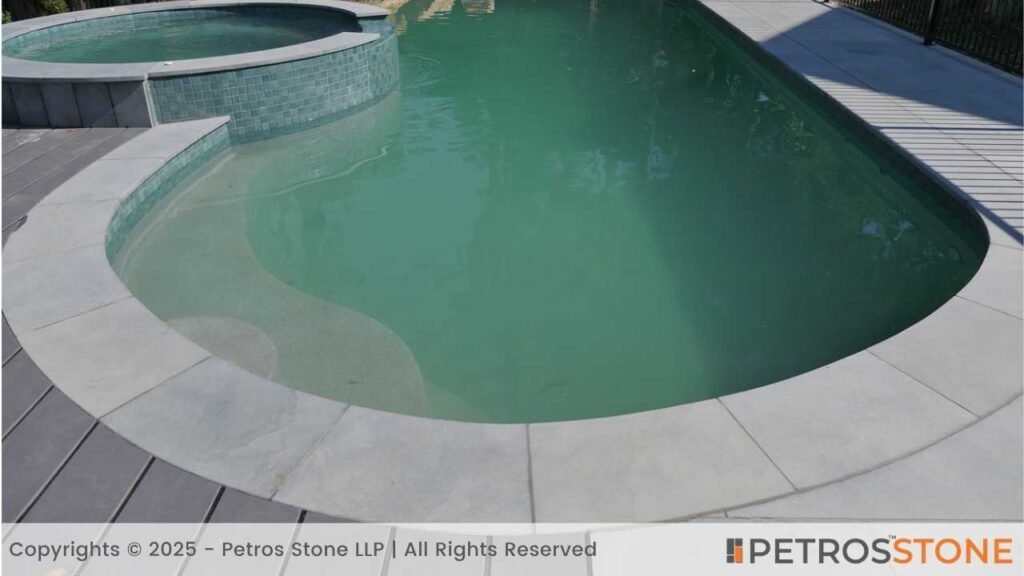
Appearance and Durability
- Lighted, uniform colouring: cream, beige, soft grey.
- Compact stone resistant to impact, chemicals and weather.
Best Design Pairings
- Supports Mediterranean, modern, or contemporary themes.
- Complements white or grey pool finishes and neutral decks.
Slip Resistance & Safety
- Textured grip is offered by honed or tumbled surfaces.
- Soft finish delivers comfort to those stepping out of the swimming pool.
3. Porcelain Pool Coping
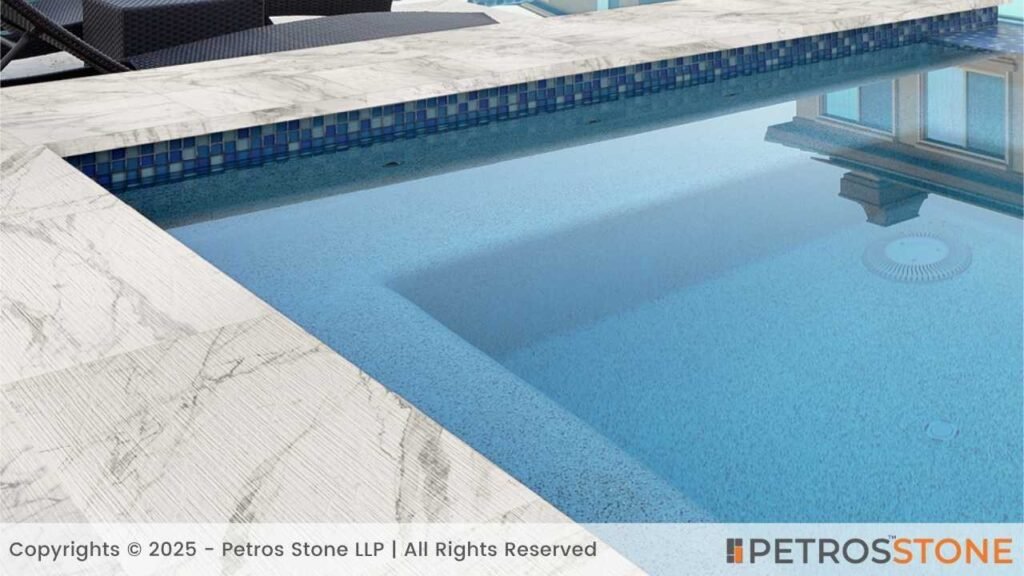
Modern Appeal and Colors
- Modern colour scheme: charcoal, cool greys, stone effect whites, wood grain.
- The same appearance, UV resistant to maintain colour stability.
Pros and Cons
Pros:
- Very sturdy, highly scratch, chip, and stain-resistant.
- Fade resistance and colour consistency.
- Low maintenance – no sealing is necessary.
- Useful to modern design that requires a clean edge profile.
Cons:
- Hard on the foot–not so kind to barefoot comfort.
- Flat sub-base, accurate spacing, stable adhesive system: precision installation required.
- Increased shipping prices and material expenses.
Porcelain vs. Natural Stone
| Feature | Porcelain | Natural Stone |
| Durability | Very High | High (softer stones) |
| Fade Resistance | Excellent | Moderate |
| Sealing Needed | No | Yes (annually) |
| Cost | Higher | Moderate |
| Finish Uniformity | Consistent | Unique & varied |
4. Bluestone Pool Coping
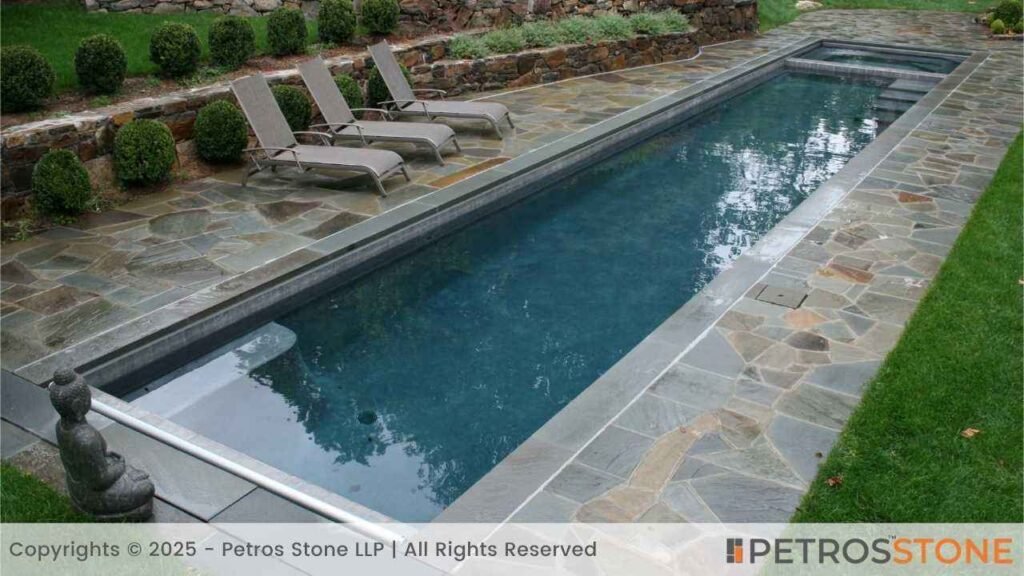
Natural Texture and Shades
- Slate-blue to charcoal-grey.
- Natural slip resistance is achieved by a subtle, rough texture.
- An excellent visual in rustic or woodland style pools.
Suitable Pool Styles
- Complements garden/woodland or backyard use of cottaging ambience.
- Combined with timber decks or natural stone patios in harmony.
Maintenance and Cost
- Needs sealing against stains and water absorption.
- Power wash annually or (2 years) to remove moss or algae.
- The price is between travertine and porcelain.
Pool Coping Stone Prices

1. Price Range by Material
The following is a rough estimate of the cost per square foot of materials only (USD):
| Material | Low End | High End | Notes |
| Travertine | $6 | $12 | Classic tones, tumbled finish |
| Limestone | $5 | $10 | Neutral shades, dense stone |
| Porcelain | $8 | $15 | Modern colours, precise cut |
| Bluestone | $7 | $14 | Rustic texture, slate tones |
| Granite | $9 | $18 | Highly durable, polished/stain-resistant |
2. Installation and Labor Costs
Labour costs vary by complexity:
- Straight and standard coping: $10–$15 per ft².
- Curved or decorative edge profiles: $15–$25 per ft².
- There may be extra costs on:
- Surface preparation and levelling decks.
- Drainage channels or waterproof membranes.
- Cutter, glue, grout, seal.
- Special-purpose or scaffolding equipment.
3. Long-Term Value vs. Initial Cost
Making wise investments today can save you money in the future:
- Porcelain and Granite: Expensive purchase, very durable, stain and fade resistant, low maintenance care- perfect for the long-term.
- Travertine and limestone: Mid-range cost, attractive look, cool to walk on-but must be sealed each year.
- Bluestone: Mid-high priced, rustic natural look, requires regular sealing and cleaning.
4. Cost Comparison Table (Material + Labor)
| Material | Material Cost | Labor Cost | Total per ft² | Expected Longevity |
| Travertine | $6–12 | $10–15 | $16–27 | 25–30+ years |
| Limestone | $5–10 | $10–15 | $15–25 | 20–30 years |
| Porcelain | $8–15 | $12–20 | $20–35 | 30+ years |
| Bluestone | $7–14 | $12–20 | $19–34 | 25–40 years |
| Granite | $9–18 | $12–20 | $21–38 | 35+ years |
Pool Coping Ideas
1. Modern Pool Coping Designs
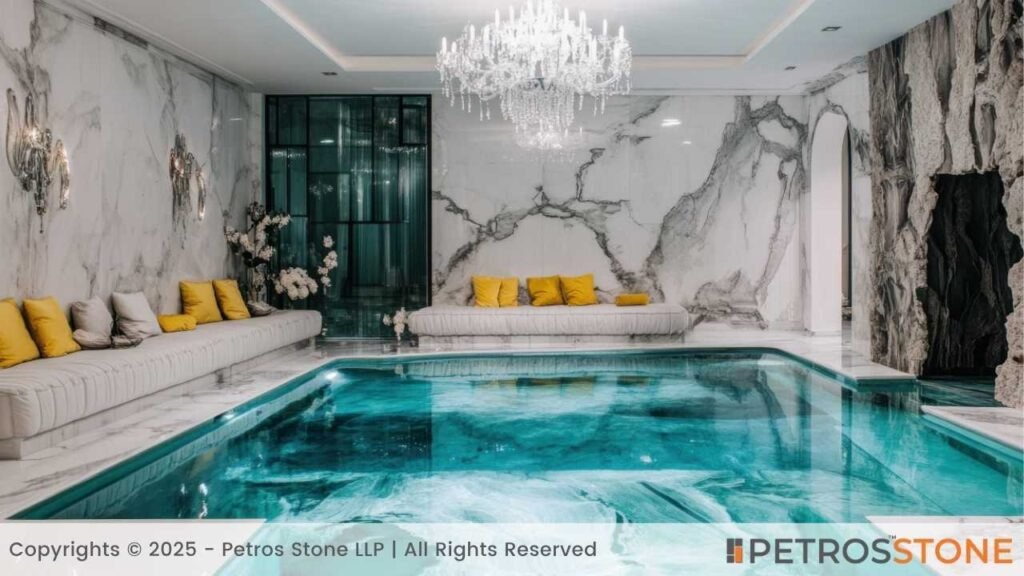
Modern pools prefer clean lines, minimalistic designs, and neutral tones:
- Rectangular or square corners produce straight, pointy lines.
- Flush or low-profile designs incorporate a pool edge into decking materials.
- Modern concrete or timber decks are complemented by dark grey or charcoal porcelain or limestone.
- The coping incorporates channel drainage to provide sleek functionality.
Visual example: Teak timber pool deck, thin charcoal porcelain coping with rectilinear edges applied flush with a linear drain.
2. Traditional Pool Coping Styles
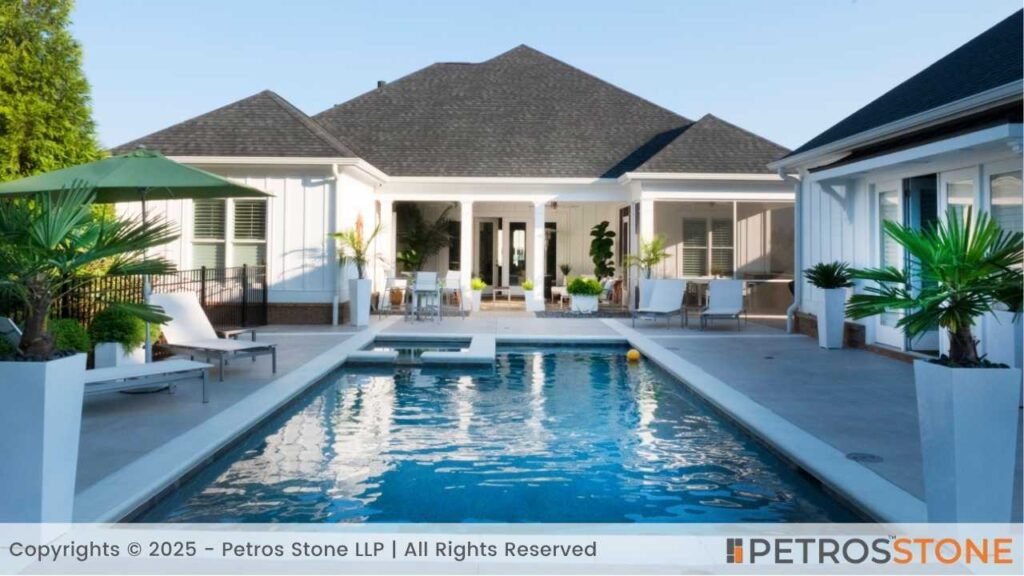
Traditional looks are about curves, texture, and natural colour:
- Bullnose rounding to a softer, inviting look and feel.
- Warm and earthy colours such as beige, cream or honey.
- Hand chiselled or tumbled finishes give rustic charm.
- Complementary decking, which includes flagstone, travertine, pavers, or stamped concrete.
Visual comparison: Buff limestone rounded bullnose edge around freeform pool and matched with tumbled travertine decking.
3. Textures, Colors, and Edge Profiles
Textures
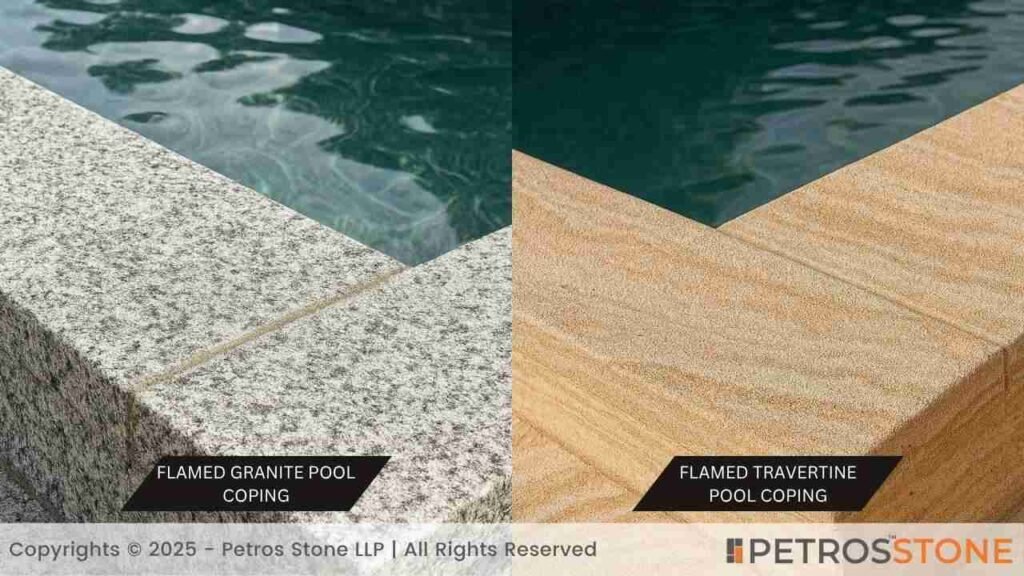
- Honed: Flat matte finish.
- Tumbled: Mildly jagged, provides extra earthiness and tenacity.
- Chiseled/Hand-cut: Rustic and natural.
- Polished: Shiny and may be too smooth to use in pool edges.
Edge Profiles
| Edge Profile | Description | Edge Profile Image |
|---|---|---|
| Bullnose | Rounded and secure. | 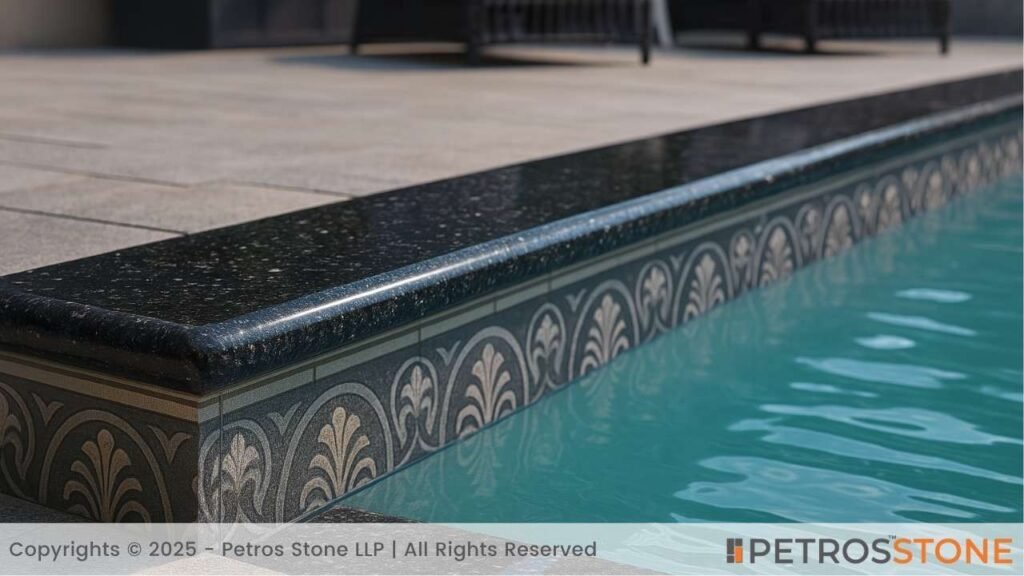 |
| Bevelled / Chamfered | Moderate angle to crisp lines. |  |
| Square / Chiselled | Modern, brash appearance. |  |
Colors
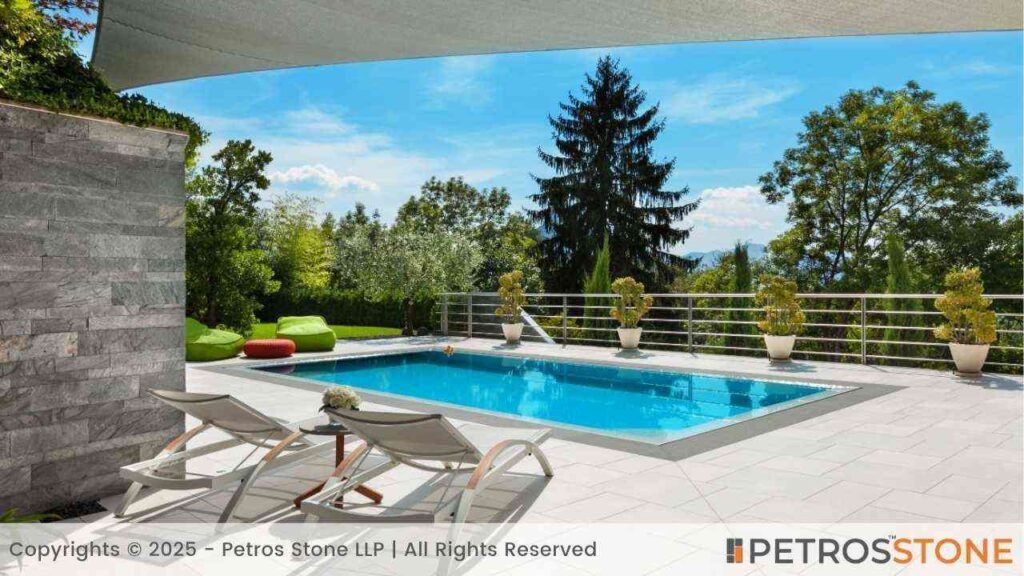
- Light colours ensure a shady edge around the pool in sunny weather- travertine, limestone.
- The dramatic, contemporary statements are provided by charcoal or dark tones, porcelain.
4. Seamless Integration with Pool Deck
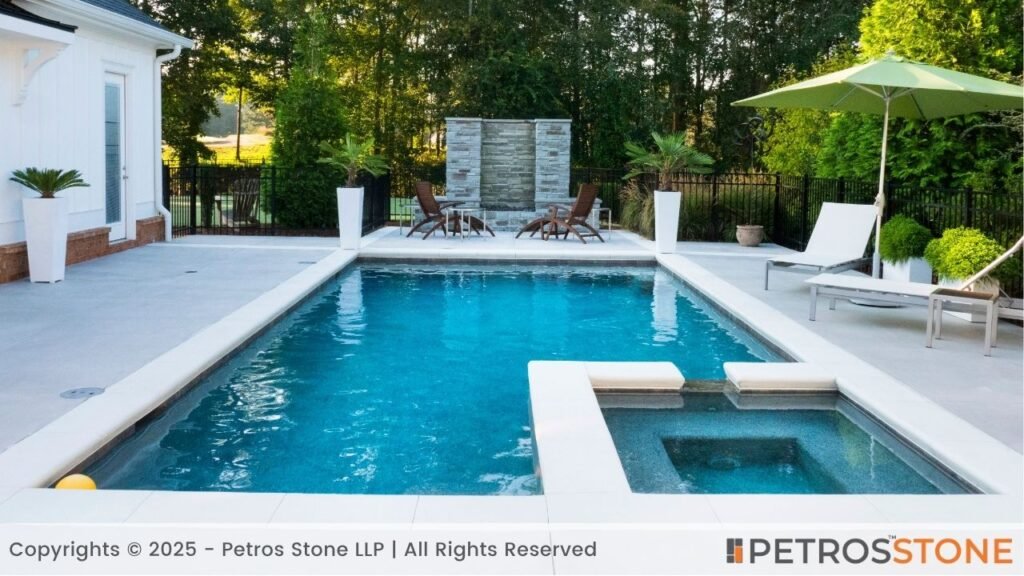
For visually unified pool areas:
- Extend deck materials along the edge of the pool- e.g., same travertine paving to deck and coping.
- Deck-to-coping grout or joint patterns.
- Purposely match or contrast edges, such as dark coping with light decking or the reverse.
- Have drainage elements (channels/slots) incorporated in the decking to preserve flow and design.
- Recess lighting or waterline accent tiles with flush coping or more sophistication.
Pool Coping Tile
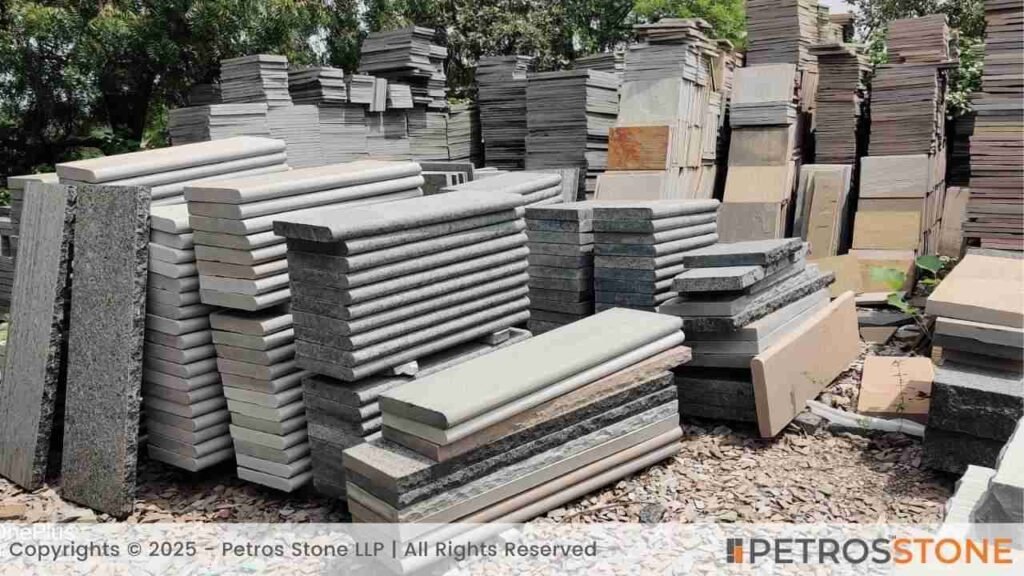
1. Differences Between Tile and Stone
| Feature | Tile | Stone |
| Material Thickness | ½″ to ¾″ – Thin, lightweight | 1½″ to 2″+ – Thicker and heavier |
| Cost | Generally less expensive ($5–$12/ft² material) | More costly ($7–$20/ft² material) |
| Appearance | Wide variety of colours, patterns, and even wood-look finishes | Natural textures and tones, each piece unique |
| Durability | More prone to chipping/cracks; not ideal for freeze-thaw climates | Very durable; withstands weather, chemicals, and heavy use |
| Slip Resistance | Can be slippery if glazed or polished; matte options are available | Typically better grip, especially with honed or tumbled finishes |
| Installation | Requires flat sub-base; easy to cut and install in straight lines | Needs leveling; heavier, more time-consuming installation |
| Maintenance | Easy to clean; usually doesn’t require sealing | Needs sealing (especially porous stones like travertine and limestone) |
| Best For | Modern styles, accent detailing, smaller budgets | Long-term investment, luxury aesthetics, and high-traffic durability |
2. Tile Materials for Pool Coping
- Ceramic Tile: Cheap alternative, glazed, lots of colours.
- Glass Tile: Highly reflective, shimmers, nice way to add accents (also slippery).
- Porcelain Tile: Long-lasting tile variant that possesses the properties of porcelain, as well as the shape of a tile.
- Mosaic Tile: Normally known to be at the water line–not complete coping, but spectacular looking.
3. Layout Patterns and Installation
- Stacked: single linear joint positioning.
- Brick bond: interlocking joints are interesting.
- Diagonal: placed at 45 degrees to dynamically design.
- With edge strip: main field framed.
- Trims and cuts: curve or round pool, tiles have to be cut and pasted and grouted with waterproof grout without moisture seeping in.
Best Natural Stone for Pool Coping
Why Choose Natural Stone?
Each slab is unique, giving a signature appeal.
- Every slab is individual and offers the signature look.
- Copings are kept cool in the sun by the natural cooling properties.
- Eco-friendly: does not need elaborate processes, lasts several decades, and is recyclable.
- Value addition: good material will make a property more attractive and increase resale value.
Top Natural Stones: Travertine, Limestone, Bluestone

- Travertine: Classic Mediterranean rocks, neutral hues, tumble texture, cold metal.
- Limestone: Eye-catching, thick, neutral and luxurious, ideal on decks of all manners.
- Bluestone: Distinct darker shade, durable, textural, rustic to transitional design suited.
Aesthetic Longevity and Environmental Benefits
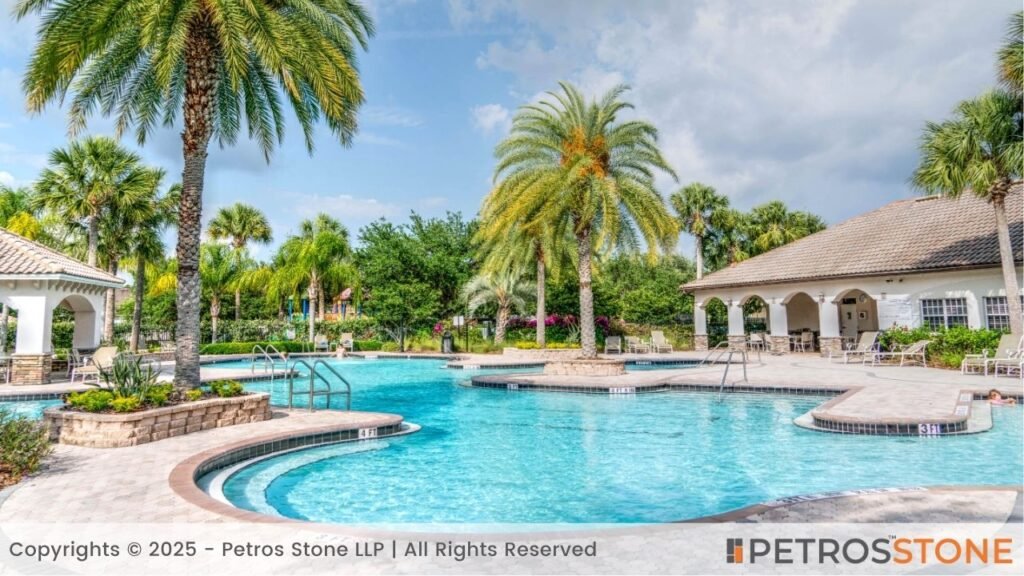
- Natural stones age beautifully- they develop patina and give character.
- Little chemicals required: typically only sealers to protect the stain.
- Longevity of materials decreases the number of replacements, limiting the term resource consumption.
Best Stone for Salt Water Pool Coping
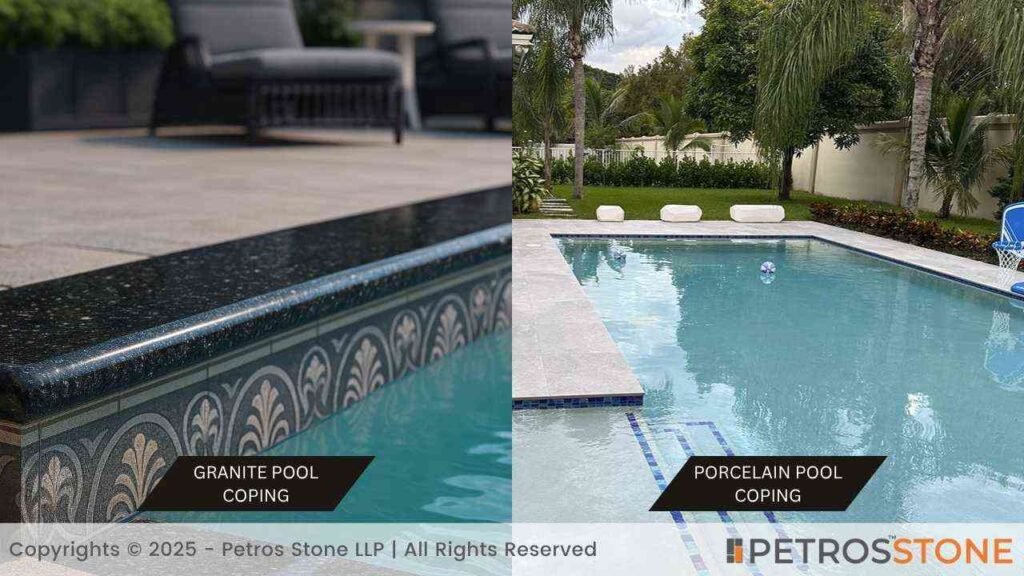
1. Salt Water Resistance in Stones
Salt pools operate on salt chlorine generation, which produces slightly salty water. Salt has the potential over time to dissolve some stones, leave stains, and reactively discolour the ground.
2. Recommended Stones: Granite, Porcelain
- Porcelain: Colourless, excellent with salt; chemically inert; non-porous.
- Granite: Insoluble-non-reactive, dense with high stain and brine resistance in its natural
3. Sealing and Care Tips
- Apply a penetrating silane/siloxane sealer that is resistant to salt.
- Clean the coping surfaces regularly to remove salt deposits.
- Clean with pH-neutral soap- avoid using acidic soap or scrubbing.
- Inspect once a year, and resealing must be done every 1-2 years, depending on usage and weather.
- Use test patches to confirm colour discolouration in the initial exposure.
Summary
When selecting a pool coping stone, it is about striking the right balance between the beauty of the product, safety, weather, and cost.
A brief material summary:
- Travertine: Eternal, cool to the touch, moderately priced, needs to be sealed.
- Limestone: Beautiful, strong, inexpensive, suits with modern design or retro.
- Porcelain: sleek finish, remarkable durability, and minimal maintenance; though more costly, upfront, it provides long-lasting value.
- Bluestone: Rustic, textured, and durable; medium to high price.
- Granite: Exceptional hardness and chemical resistance combined make it the top choice for salt pools, yet the premium price tag remains.
Keep in mind that the overall expense encompasses both material and labour. Porcelain and granite provide exceptional durability; Enlisting a professional installer alongside diligent sealing and maintenance can prolong the lifespan of your coping by 25–40 years or longer.
Feel free to get in touch for a free consultation, quote, and get a detailed understanding from our experts here at Petros®. Visit https://petrosstone.com/ or call +91-8446360361 and WhatsApp

Hello!
I’m Dr Mridali, a content writer with a background in dentistry and a passion for turning complex topics into clear, engaging stories. From healthcare to architecture, I create blogs that inform, educate, and connect with readers. With every piece, I aim to blend accuracy with creativity to make information truly valuable.
Brown Granite
White Galaxy Granite
Blue Bahia Granite
Silver Cloud Granite
Black Pearl Granite
Dallas White Granite


